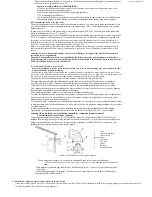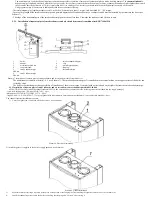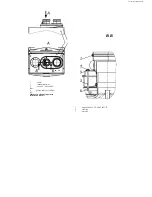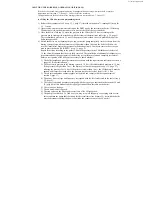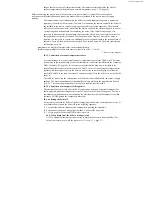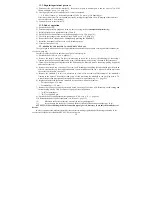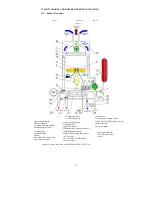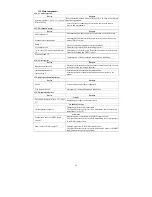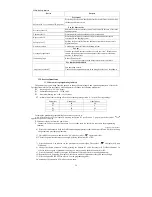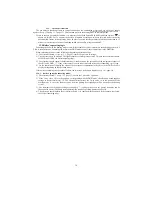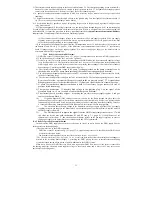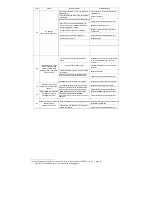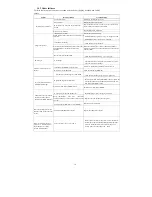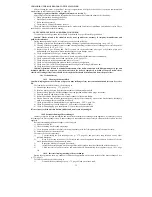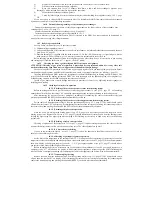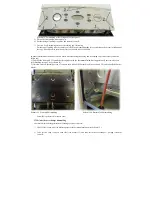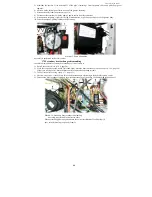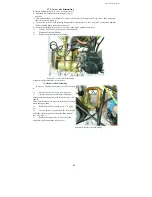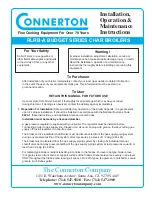
Руководство для технического персонала
31
5)
The electronic board supplies voltage to the fan’s electrical motor 28. The fan starts operating (it can be heard). By
means of air flow a pressure difference is created in the air pressure switch 27. A signal about draught presence
comes to the electronic board 11. If there is no signal, the boiler’s launching stops;
6)
A pause for combustion chamber ventilation is held (it is necessary for gas removal in case of previous failed
launching)
7)
The ignition transformer 12 transfers high voltage to the ignition plug 5 on the signal of the electronic board 11
in~ 10 sec. (a sound of current discharge can be heard);
8)
The electronic board 11 provides a signal for opening the gas valve in the gas supply regulator 9, and gas comes
to the burner block 4;
9) If ignition happened (if the casing is removed, you can see the flame through the glory-hole), an ionization plug
6 sends a signal to the electronic board about successful ignition. If there is no signal from the ionization plug, the
electronic board 11 repeats the procedure of boiler’s launching from the beginning. There are 2 consecutive launching
attempts taken. If both attempts fail, the electronic board stops ignition;
10)The electronic board 11changes voltage in the modulator coil of gas supply regulator 9.The gas supply
regulator increases gas supply to the burner block 4 up to maximal power in order to quickly warm the heat
carrier in the heating system up to the set temperature;
11)The electronic board compares the signal from the CH temperature sensor 16 with the value set by the user with
the buttons К3 and К4 (see p. 3.1, page 8). If the difference of set temperatures is more than 1
°С, the electronic
board 11changes voltage on the gas supply regulator 9 in order to change gas supply to the burner block in
accordance with the CH’s requirement.
13.4.2
Boiler’s operation in DHW mode:
1)
DHW flow sensor 23 sends a signal (see p. 13.1, page 27) about presence of water flow in DHW supply circuit;
2)
The electronic board 11 checks the 3 way valve’s position;
3)
If the 3 way valve 18 is in the position, corresponding to the DHW mode, the electronic board supplies voltage
to its electrical motor 19. The electrical motor moves the 3 way valve 18 to the position corresponding to the
DHW supply mode. As a result the heat carrier from the primary heat exchanger is directed to the secondary
heat exchanger 3, providing the DHW supply mode this way;
4)
The electronic board provides voltage to the pump 7
(voltage presence on the pump’s terminals can be
checked with a tester).The pump starts operating (the sound of operating pump can be heard);
5)
The electronic board inquires the air pressure switch 27, its contacts must be opened. If the contacts are closed,
the boiler’s launching stops;
6)
The electronic board provides voltage to the fan’s electric motor 28. The fans starts operating (it can be heard).
By means of air flow a pressure difference is created in the air pressure switch 27. A signal about
draught presence comes to the electronic board 11. If there is no signal, the boiler’s launching stops;
7)
A pause for combustion chamber ventilation is held (it is necessary for gas removal in case of
previous failed launching);
8)
The ignition transformer 12 transfers high voltage to the ignition plug 5 on the signal of the
electronic board in~ 10 sec. (a sound of current discharge can be heard);
9)
The electronic board provides a signal for opening the gas valve in the gas supply regulator 9, and gas
comes to the burner block 4;
10)
If ignition happened (if the casing is removed, you can see the flame through the glory-hole), the
ionization plug 6 sends a signal to the electronic board about successful ignition. If there is no signal from the
ionization plug, the electronic board repeats the procedure of boiler’s launching from the beginning. There are
2 consecutive launching attempts taken. If both attempts fail, the electronic board stops ignition;
11)
The electronic board changes voltage in the modulator coil of gas supply regulator 9.The gas supply
regulator increases gas supply to the burner block up to maximal power in order to quickly warm the water in
the DHW supply system up;
12)
The electronic board compares the signal from the DHW circuit temperature sensor 17 with
the value set by the user with the buttons К1 and К2 (see p. 3.1, page 8). If the difference of set
temperatures is more than 1
°С, the electronic board changes voltage on the gas supply regulator in order to
change gas supply to the burner block in accordance with
the CH’s requirement.
13.4.3 Boiler’s operation in combined mode
In this mode the DHW supply has a priority over heating. In case of no water flow on the DHW supply line the
boiler operates in the heating mode.
If there is water flow in the DHW supply line:
-
DHW flow sensor 23 actuates (see p. 13.1, page 27). A signal about presence of water flow in the DHW circuit
is sent to the electronic board;
-
The electronic board supplies voltage to the electric motor 19 of the 3 way valve 18
.
-
The electric motor moves the
3 way valve 18
. As a result the heat carrier from the primary heat exchanger is
directed to the secondary heat exchanger 3, providing the DHW priority this way (water inlet into the heating
system is blocked during all the period of water withdrawal in the DHW system).
When water flow in the DHW line stops (there is no signal from DHW flow sensor 23) the boiler is rendered to
the heating mode (the electronic board supplies voltage to the electric motor and it moves the 3 way valve to the
position for the heating mode).
Summary of Contents for NEVALUX-8230
Page 35: ...Assembly is performed in reverse order Scheme 23 Heat exchanger dismantling...
Page 41: ...48...
Page 47: ...Ignition and ionization plugs in the assembly pos 67...
Page 54: ......
Page 55: ......

